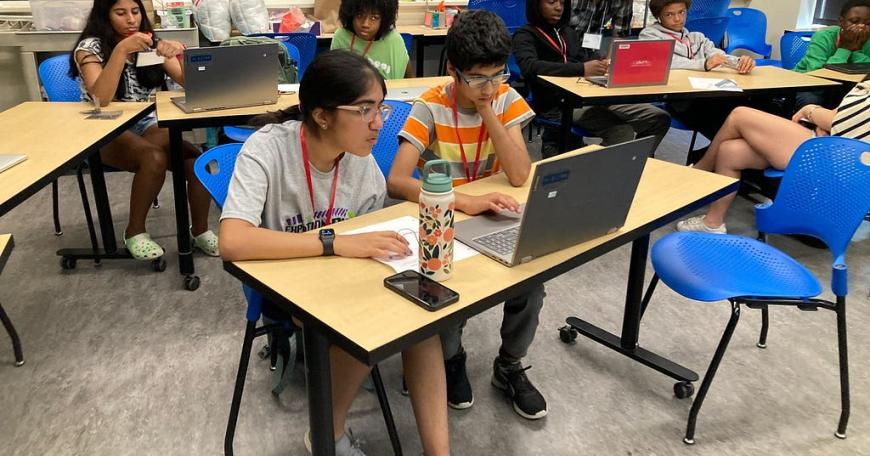
Free STEAM resources and activities for pK-12 classrooms from MIT
By Katherine Ouellette
It’s never too early to teach learners the MIT way. Educators around the world can introduce pK-12 learners to STEAM topics (science, technology, engineering, art, and math) using free educational materials from MIT Open Learning. These activities, curricula, and other resources were designed by MIT researchers to be fun and effective.
General STEAM resources
Start engaging learners today in a variety of STEAM topics with these robust resources from MIT.
- MIT pK-12: Part of Open Learning, MIT pK-12 creates meaningful learning experiences for young people and educators around the world through co-design, capacity building, and impactful work at scale.
- Full STEAM Ahead: These high-quality MIT resources for teaching and learning online cover a variety of subjects.
- STEAM Learning Architecture: A Framework for Educational Innovation: This learning-centered framework, developed by MIT pK-12, uses pedagogical approaches that span academic, social, and personal development.
- Public Library Innovation Exchange: These creative, research-based STEAM learning experiences are developed for the public library setting.
- K-12 videos: These educational videos are designed to promote STEAM literacy.
- MIT OpenCourseWare: On a platform offering thousands of MIT educational materials, this selection of chemistry, physics, and engineering courses are tailored for the high school level.
- First Year STEM: These online courses and resources in biology, calculus, chemistry, computer science, and physics are taken by many first-year MIT students.
Artificial intelligence activities
Get learners thinking about everyday AI tools, the power of data, and AI designs with these Full STEAM Ahead activities, designed by MIT Media Lab’s Personal Robots group and MIT App Inventor.
- Introduction to AI (ages 5–8): This activity covers the basics of artificial intelligence.
- Mystery YouTube Viewer (ages 7–9): This activity helps young people learn about data privacy.
- Introduction to Machine Learning and Image Classification, Part 1 and Part 2 (ages 14–18): These beginner-level activities help learners create apps that identify objects.
- Expression Match Game (ages 14–18): This beginner-level activity lets learners train their own image classifier to recognize different facial expressions.
- Voice Authentication Diary App (ages 14–18): This beginner-level activity teaches learners how to train an audio classification model to detect a specific voice to unlock a personal diary app.
- Therapist Bot Tutorial (ages 14–18): This intermediate-level activity lets learners program a mobile app to simulate conversation.
- Rock, Paper, Scissors Tutorial (ages 14–18): This advanced-level activity helps learners build a mobile app that trains itself to win rock-paper-scissors.
Climate change activities
Introduce learners to the science of climate change, climate solutions, and climate action with the Day of Climate curriculum designed by MIT pK-12 and the Day of AI curriculum designed by the MIT RAISE Initiative.
- Day of Climate: This free, hands-on curriculum of lessons and activities will introduce K-12 learners to climate research and how it shapes their lives in spring 2025. Learn more.
- Making Sense of Our Surroundings (ages 8–18): This Day of AI curriculum introduces basic concepts of data literacy through the lens of weather and climate change.
- Ecobit Explorers (ages 11–18): This curriculum explores the fundamentals of data collection, analysis, and visualization through the environment.
- Telling Climate Stories with Data (ages 14–18): This Day of AI curriculum shows how data analysis pipelines and machine learning can help “tell a story” of the human impacts of climate change with datasets.
- IceMelt: Modeling and Predicting Climate Change (ages 14–18): This Day of AI curriculum teaches learners how to use MIT App Inventor to analyze datasets of lake ice data to model and predict how climate change might impact these measurements in the future.
Coding resources
Give learners hands-on experience with coding, data analysis, and app development with tools developed by the MIT RAISE Initiative and others.
- MIT App Inventor (all ages): This visual programming tool helps learners build fully-functional mobile apps that can have a global impact.
- CoCo (all ages): This co-creative platform, developed by MIT Media Lab researchers, lets learners code together in real time.
- Computational Thinking (ages 11–18): This MIT App Inventor curriculum encourages learners to think computationally while making mobile apps.
- Data Science and Sensors (ages 13–18): This MIT App Inventor curriculum helps young people learn about how to collect, visualize, and analyze data from a spreadsheet.
- The Internet of Things: Data Acquisition and Analysis (ages 11–18): This MIT App Inventor curriculum teaches learners how to use the internet of things to collect and analyze real-world data for solving important problems.
- OctoStudio (ages 7–12): This mobile coding app, developed by the MIT Media Lab’s Lifelong Kindergarten group, helps learners create interactive animations and games on their phones.
- Scratch (ages 8 and up): This programming language, developed by the MIT Media Lab’s Lifelong Kindergarten group, encourages learners of all ages to create digital stories, games, and animations.
MIT pK-12 and the RAISE Initiative (Responsible AI for Social Empowerment and Education) are both part of MIT Open Learning. MIT pK-12 creates meaningful learning experiences for young learners and educators around the world through co-design, capacity building, and impactful work at scale. Projects include Full STEAM Ahead, Public Library Innovation Exchange, and Day of Climate. MIT RAISE Initiative is a collaboration between MIT Open Learning, Media Lab, and Schwarzman College of Computing that helps prepare learners and workers for an AI-powered society. Projects include Day of AI and MIT App Inventor.
Free STEAM resources and activities for pK-12 classrooms from MIT was originally published in MIT Open Learning on Medium, where people are continuing the conversation by highlighting and responding to this story.

